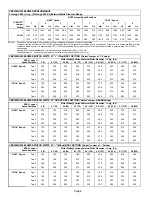
Page 10
I−APPLICATION
CBX32MV blower coils are designed for R410A
applications only.
All major blower coil components
must be matched according to Lennox
recommendations for the unit to be covered under
warranty.
Refer to the Engineering Handbook for approved
system matchups. A misapplied system will cause erratic
operation and can result in early unit failure. The units come
with factory installed check and expansion valve for all
applications. It has been installed internally and is accessible if
required.
II−UNIT COMPONENTS
A−Control Box
The CBX32MV control box is shown in figure 2. Line voltage
and electric heat connections are made in the control box.
Optional electric heat fits through an opening located in the
center of the control box. When electric heat is not used,
knockout plates cover the opening. The electric heat control
arrangement is detailed in the electric heat section of this
manual.
B−Terminal Strips (TB1 and TB2)
All CBX32MV units are equipped with two low voltage
terminal strips (TB1 and TB2) located in the control box.
See figure 2. The strips are used for making up all indoor
thermostat wires.
All CBX32MV units have factory installed jumpers
connecting DS to Y1, R to O and Y1 to Y2. These jumpers
will have to be removed in certain unit application. See table
1.
TABLE 1
Application
Remove Jumpers
Harmony II, CCB1,
SignatureStat
t
DS to Y1
Heat Pump
R to O
Two−Stage Cooling
Y1 to Y2
C−Transformer (T1)
All CBX32MV series units use a single line voltage to
24VAC transformer mounted in the control box. The
transformer supplies power to the control circuits in the
indoor and outdoor unit.
D−Blower Relay (K20)
All units use SPDT relay to energize the blower motor in
response to heating demand. The relay coil is energized
when the 1st stage electric heat relay closes. When K20 is
energized, its N.O. contacts close to energize jack plug
JP46 pin 2 (located on blower drive control A15). When
JP46−2 is energized, the blower drive control immediately
energizes the blower on heating speed. Heating speed will
override cooling speed. K20−2 will energize the
economizer if used ( refer to wiring diagram.)
FIGURE 3
BLUE
YELLOW
ORANGE
RED
BLACK
240 VOLTS
208 VOLTS
PRIMARY
SECONDARY
208 / 240 VOLT TRANSFORMER
CB8
E−Circuit Breaker (CB8)−1 units & Fuse (F1)
All transformers used in the CBX32MV−1 series units are
equipped with internal secondary voltage overcurrent
protection. Each transformer uses a manual re−set circuit
breaker (CB8) located on the transformer. The circuit
breaker is connected in series with the blue secondary
voltage wire and is rated at 3.5 Amps. CBX23MV−2 units
and later are equipped with a fuse (F1) rated at 3 amps. F1
is connected in series with the blue secondary voltage wire
and like CB8 provides overcurrent protection.
F−Plastic Drain Pans
Both upflow/downflow and horizontal drain pans are
provided and installed on the CBX32MV units. The drain
pans are made from fiberglass-filled plastic. The drain hole
is used for right-hand air discharge only, and must be
plugged when the unit is configured for left-hand air
discharge (see page 24 for horizontal left-hand
application). Each pan has a set of connections, one for a
primary drain and one for an auxiliary drain.
G−Coil
All CBX32MV series units have dual slab coils arranged in
an "A" configuration. Each coil has two or three rows of
copper tubes fitted with ripple-edge aluminum fins. A check
and expansion valve complete with screen feeds multiple
parallel circuits through the coils. The coil is designed to
easily slide out of the unit cabinet.
Optional electric heating elements are sequenced so
blower relay K20 operates on a first on/last off basis.
H−Variable Speed Blower Motor (B3)
CBX32MV series units use a single-phase variable-speed
motor. See figure 4. A solid-state controller is attached to
the motor.











































